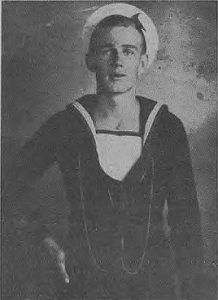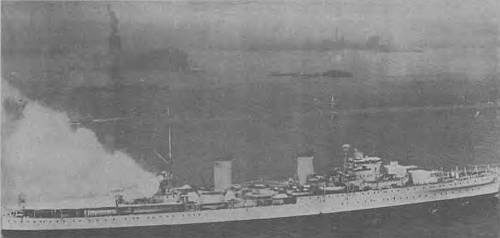- Author
- Holmes, L.F.
- Subjects
- Biographies and personal histories
- Tags
-
- RAN Ships
- None noted.
- Publication
- September 1974 edition of the Naval Historical Review (all rights reserved)
In previous editions of Naval Historical Review biographies of admirals, captains and distinguished officers have been featured. This biography is of a captain’s bugler, Ordinary Seaman Alan Gee, who served in HMA ships Vampire, Canberra and Perth. Alan Gee is now almost totally blind and his story has been written by Mr. L. Holmes.

ABOVE THE FIREPLACE of the homestead living room hung a Ray Parkin watercolour of one of the subjects of our talk, namely HMAS Perth, while the other subject was my host, Alan H. Gee, former Ordinary Seaman on that gallant ship, who had kindly agreed to tell me of his and Perth’s story.
Alan was born at Beechworth, Victoria, on October 10 1919, and, although he cannot trace any family connections with the sea, he remembers always being keen on stories of ships and the sea.
He joined the Royal Australian Navy on March 9 1937, and was sent to Crib Point, where in the process of becoming a ‘trained man’ he recalls some six weeks of sea training in HMAS Vampire.
His first ship was HMAS Canberra with Captain W. Patterson in command. When it was learned that Ordinary Seaman First Class A. H. Gee had played the bugle in the school band, he was duly installed as ship’s bugler under Commander F. E. Getting, who was later to die on the bridge of the ship. Gee was assigned to the quarterdeck under Lieutenant Peek, his action station being in the shell room of Y turret.

In March 1939 he left Canberra and, after a spell of leave, embarked in the Blue Funnel Line steamer Autolycus, bound for Portsmouth with the ship’s company to commission the RAN’s second Improved Leander class light cruiser HMAS Perth, formerly HMS Amphion.
The commissioning ceremony on June 29 1939 at Portsmouth was attended by the Duchess of Kent, and Bugler Gee was provided with a silver bugle for the occasion.
The same evening, with Hood and Ark Royal and many other Royal Navy units at the anchorage, our bugler mistook the preparatory flag for ‘sunset’, and engaged in the premature blowing of that signal some five minutes too early, an action which led to the buglers of every ship in harbour following suit! Gee remembers being suitably ‘spoken to’ by the Gunnery Officer, Lieutenant W. S. Bracegirdle, who told him he was probably the only person in history who had caused the British flag to be lowered before time.

Perth had a shakedown cruise in the Channel and left Portsmouth finally on July 26 bound for Australia via New York, where that city’s famous Mayor, La Guardia, made the ship guest of the city for the day. Among the visitors to the ship was former world heavyweight boxing champion Jack Johnson, who recalled his visit to Australia and his memorable fight with Tommy Burns in Sydney.
Perth, commanded by Captain H. B. Farncomb, sailed for Kingston, Jamaica, on the West Indies station and waited in the Caribbean for the then inevitable declaration of war.
Orion was also on the West Indies station and she and Perth spent the first few weeks of the war fruitlessly chasing German shipping in the area. On October 4 the Australian cruiser and HMS Berwick escorted KJ.3, a forty-five ship convoy, from Kingston to a point roughly three hundred miles west of the UK. Perth suffered damage to her superstructure from a hurricane which she encountered on the return passage to Bermuda.
Other highlights Seaman Gee recalls from this period include: going to action stations after intercepting signals from a German warship thought to be Deutschland, but failing to contact same; leaving Halifax, Nova Scotia, and steaming up the coast of Greenland in a vain search for survivors of the gallant AMC Rawalpindi, sunk in action with Scharnhorst and Gneisenau; hearing a running description of the Battle of the River Plate broadcast over the ship’s loudspeaker system from a commentary provided live from an American plane over the scene.
March 2 1940 found Perth homeward bound through the Panama Canal, and on arrival back in Sydney Gee was taken from the ship between the Heads and No. 1 buoy suffering from appendicitis.
On his discharge from hospital he was sent to HMAS Penguin and was made Cox’n of Penguin’s motor boat, a post which was to give him a great knowledge of Sydney Harbour.
Then came news that he was one of fifty trained men drafted to Britain to man the new N Class destroyers.
However, fate had decreed that Alan Gee and Perth belonged together. Before he could sail for the UK he was drafted to the cruiser as ship’s bugler under Commander Adams. Once again he trod the familiar decks of the happy ship he knew so well. Alan repeatedly told me that a splendid ‘esprit de corps’ pervaded Perth and it remained right up to the end.
Captain Bowyer-Smyth took command of Perth in mid-1940 and after a period spent on the Australia station, which included convoy escort duties with such notable charges as Queen Mary, Queen Elizabeth and Aquitania bound for the Middle East, Perth herself sailed from Fremantle in November to relieve her sister ship HMAS Hobart on the East Indies station.
Following a short spell of escort work in the Red Sea, Perth arrived at Alexandria on Christmas Eve 1940, to relieve her other famous sister ship HMAS Sydney, whose Mediterranean tour of duty was over. It was at this port she took on her distinctive camouflage. Perth began her action-studded service with the Mediterranean Fleet, working mostly with HMS Ajax. She was in the action at Matapan as well as in the thick of things in the withdrawals from Greece and Crete. In the latter evacuation she was seriously damaged by a bomb hit.




